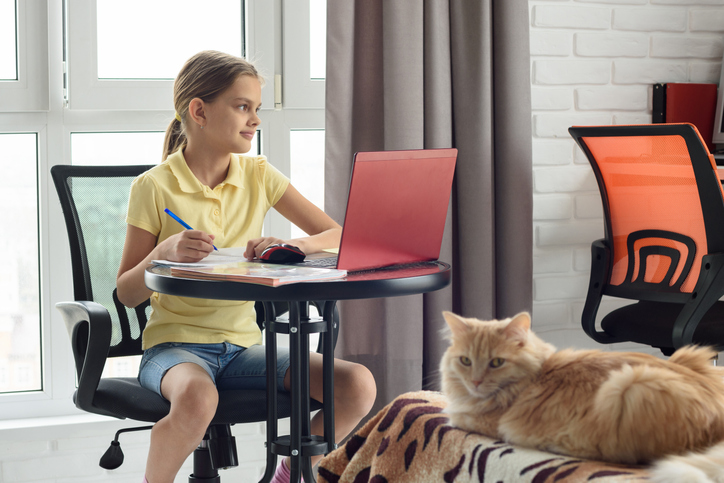 Studying in bed? Doing homework on the couch while watching television? Hybrid and remote learning are challenging for so many kids and parents. If you want your child or teen with ADHD to show up for their remote classes with focus and concentrate on their homework/classwork, they’ve got to have a designated study space. For many students with attention or learning challenges, going to class in their rooms with their doors closed may well mean that they are multitasking, distracted and switching from school to social media or gaming. Despite their pushback and complaining, they need an ADHD-friendly environment to help them thrive with at-home learning with ADHD.
Studying in bed? Doing homework on the couch while watching television? Hybrid and remote learning are challenging for so many kids and parents. If you want your child or teen with ADHD to show up for their remote classes with focus and concentrate on their homework/classwork, they’ve got to have a designated study space. For many students with attention or learning challenges, going to class in their rooms with their doors closed may well mean that they are multitasking, distracted and switching from school to social media or gaming. Despite their pushback and complaining, they need an ADHD-friendly environment to help them thrive with at-home learning with ADHD.
School is still in session.
While it’s important to empathize with your kids’ boredom or frustration, you’ve also got to make sure they can get their work (or some of their work) done each day.

In addition to establishing a thoughtful daily plan, you can facilitate academic focus and participation by putting together a home study spot. These study spaces don’t have to break the bank. What’s most important is that you’re clarifying what it means to be working versus what it means to be off-duty and where this activity will occur. When kids with ADHD and learning challenges have routines and areas that are dedicated to learning, it’s easier to begin and stick with academic tasks.
Of course, you can’t reproduce school at home. But you can set up an environment that mimics school as much as possible. This aids kids to enter a space that is conducive to thinking and study while simultaneously fosters the organization of their materials, books and technological devices. Remember, you’re entitled to having IEP and 504 accommodations during this time, so ask your school for any resources or tips you may need.
Create a supportive at-home learning environment for kids and teens with ADHD:
1. Create a weekly family meeting.
This is a time to discuss expectations, concerns, review routines and study plans and explore options for things that aren’t working. When you have a weekly meeting, everybody knows that they talk about what they like and what they don’t at a specific time just for that purpose. Some families do this twice a week for shorter discussions; others do it once a week for longer check-ins. Brainstorm what will work with your kids: when they participate in creating a plan, they’ll have more buy-in. Of course, as the parent, you get to make the final decision but please take their opinions into consideration.
2. Make a daily routine and post it.
Kids with ADHD especially benefit from some structure and knowing what to expect. Break up the day into blocks of time forgoing to classes, studying on their own (worksheets, projects, assignments), movement and snack breaks, lunch, going outside, homework, chores and fun screen time.

Be as specific or general depending on what suits your child or teen. Some kids like having activity periods and they can choose what to do from an agreed upon list; others like a more predictable plan. There’s no one-size fits all for at-home learning with ADHD.
Whatever you choose, post write it down and post it in the kitchen and in their bedroom. Visual reminders are key for these alternative learners. Try to work alongside your kids or in their presence so it’s clear that certain blocks of time are family work time. Then you can observe their level of participation, take breaks together or offer academic support.
3. Name a study space and personalize it.
 Whether it’s the same spot at the kitchen table, a folding tray that you set up each morning or a desk in a common office, decide where your child will study. Make sure your kids have headphones and are separated into different rooms or different areas of the same room.
Whether it’s the same spot at the kitchen table, a folding tray that you set up each morning or a desk in a common office, decide where your child will study. Make sure your kids have headphones and are separated into different rooms or different areas of the same room.
Consider getting desk dividers if you have more than one child at home are they are sharing a table. Adjust their screen height so it’s at eye level to avoid neck and back pain, the brightness to reduce eye strain and make sure their feet can reach the floor so they are grounded.
Put together a special storage space like a locker for their books, notebooks or other supplies: use a plastic box, milk crate or make a cubby. This will help them organize their stuff. Discuss how they can personalize or decorate their home study space to make it more comfortable and inviting.
4. Foster time management.
Kids with ADHD often struggle with time blindness. They don’t understand what time feels like, and they’re not aware how to keep track of it. Purchase an analogue clock or timer to teach them this skill. They  need to see time move to grasp it.
need to see time move to grasp it.
Help kids engaged in at-home learning who have ADHD use technology to their advantage–set up alerts and alarms on their phones, or use banners on their devices as reminders. Put these clocks and timers in their study space.
If your child or teen has trouble with time management or completing assignments, talk to the school and ask for assistance.
5. Practice empathy.

Just as it is hard for you to get things done at home sometimes, it’s even harder for your child or teen. Instead of anger and resentment, go with compassion. Most kids don’t want to learn from home any more than you want them there.
In those tough moments, manage yourself before dealing with your son or daughter. When you’re calmer, you can be more open and caring towards them. They simply don’t have the mature brain that you do to process all of this disappointment, isolation and distress.
If they are getting upset, they are showing you that they lack the personal resources needed for the task at hand.Acknowledge their frustration first; problem-solve later. Your empathy will go a long way to diffusing the intensity of their situation and build deeper, lasting connections.
Read more blog posts:
Watch on Dr. Saline’s YouTube Channel:
Deeper Dive: https://drsharonsaline.com/product/online-learning-tips-for-parents-bundle/ https://drsharonsaline.com/product/home-seminar/
 It’s essential for parents and caregivers to take care of themselves during these times because we’re talking about a marathon, not a sprint. When you listen to the talk on an airplane about oxygen masks, you’re told to put one on yourself first and then on a child. It’s the same principle here. Factoring in self-care to an already full life of work, family and now hybrid learning can be complicated. In fact, it’s usually the first thing to go out the window when people are stressed when it should be one of the last. You have to take care of yourself so you can take care of others. Exercise, nutrition and emotional support are key elements to helping you run this long, arduous race. Here are a few tips:
It’s essential for parents and caregivers to take care of themselves during these times because we’re talking about a marathon, not a sprint. When you listen to the talk on an airplane about oxygen masks, you’re told to put one on yourself first and then on a child. It’s the same principle here. Factoring in self-care to an already full life of work, family and now hybrid learning can be complicated. In fact, it’s usually the first thing to go out the window when people are stressed when it should be one of the last. You have to take care of yourself so you can take care of others. Exercise, nutrition and emotional support are key elements to helping you run this long, arduous race. Here are a few tips: 



 need to see time move to grasp it.
need to see time move to grasp it.
